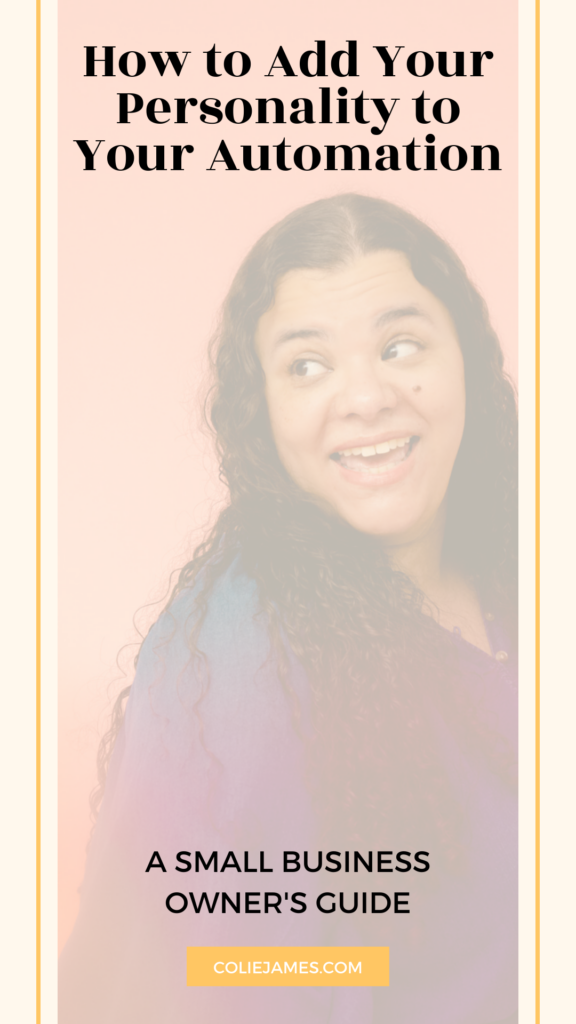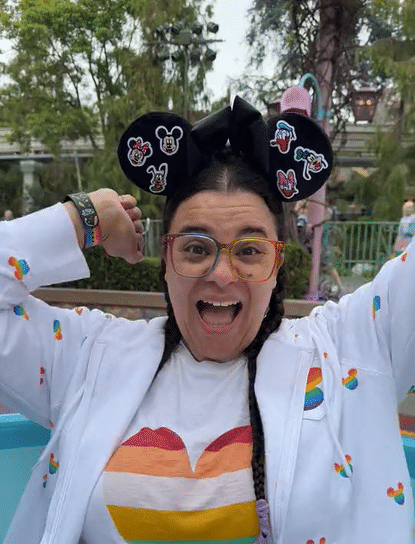Finally stop overthinking what to say and when. This free guide helps you write clear, consistent emails that sound like you — and build trust without burnout.
GRAB THE Client Experience Email GUIDE!
Blog Categories
A podcast where you join me (Colie) as I chat about what it takes to grow a sustainable + profitable business.
Business-First Creatives Podcast
CRM Guru, Family Filmmaker, and Host of the Business-First Creatives podcast. I help creative service providers grow and streamline their businesses using Dubsado, Honeybook, and Airtable.
Hey, I'm Colie
Do you cringe a little when you hear the word “Automation”? Are you a small business owner that feels the urge to personalize every single email (even when it isn’t necessary)? If so, you’re in the right place. Today, I’m diving into how to add your personality to your automation. From crafting engaging automated lead responses to the importance of thorough testing, we’ll cover it all. Sit back, relax, and let’s make your client communications as vibrant and unique as you are!
I discussed all this and more on the Big Fun Content podcast with Deanna Seymour. If you want to listen to the full podcast episode, this episode was replayed on Business-First Creatives during Colie’s Summer Sabbatical.
PS: Before we dive in, welcome to my corner of the internet if we haven’t met yet. I’m Colie – your new systems fairy godmother. Got questions or need a hand fine-tuning your systems and strategies? I’m here to help! Learn more about me here.

Adding Personality to Your Automation
Before I tell you how to add your personality to your automation, I get a lot of pushback from people who say, “I don’t want to send automated emails. I need to personalize them.” First of all, I get it. Personalization is key! But I have an answer for that (so keep reading).
The second concern they have is that automated emails are going to sound robotic. And again, I can solve all of that in like 10 minutes. Because I agree with you. Every single email you send, whether it’s from your CRM or Gmail, needs to sound like you. It needs to have your specific voice. But that does not mean it can’t be automated!
Finding Your Unique Voice
The reason I stress this is that a lot of people get caught up in sending “professional” emails. But then, when clients meet you in person, you don’t sound like the person they’ve been communicating with. Take me for example. I’m loud. I love Disney. I like to cuss and talk about trash reality TV shows.
But guess what? I include all of that in my client communications, and 90 percent of them are sent automatically. If you do a good job of identifying who needs what email and writing it in your voice, no one will ever feel like they are communicating with a robot (trust me!).
Infusing Personality Without Being an Extrovert
Another thing I’ve had clients tell me when I suggest adding personality to your automation is that it’s hard when you’re an introvert. But just because you’re not an extrovert like me doesn’t mean you can’t do it! If the thought of creating a GIF of you waving makes you uncomfortable, start with something familiar. Use GIFs of NeNe Leakes or Carrie Bradshaw from Sex and the City. These popular personalities can help ease you into the process.
Once you get comfortable, you can switch to GIFs of yourself (if you want to). It’s as easy as waving, blowing kisses, or jumping up and down to show excitement when someone books your services. This is a great way to infuse personality into your client communications.
Let me give you a few examples.
Let Me Give You An Example: The Thank You Email
Let’s talk about thank you emails, which, is one of the emails you should be sending automatically (but I know that many of you don’t). Every time someone inquires, books your services, fills out a form, or takes any action you told them to take, you need to be saying thank you.
One fun way to do this is with GIFs. You can learn how to make your own GIFs, like from Deanna Seymour’s amazing course, or use ones from your favorite shows like Schitt’s Creek. A lot of my GIFs of me were made at Disney—spinning on the teacups, waving next to Dumbo, or drinking a fantastic watermelon lemonade. It’s a fun and easy way to add your personality and “you-ness” into an automated email!
Another Example: Your Request Emails
Beyond thank you emails, there are also “please do this” emails. Anytime you ask clients to take a step—like booking you, filling out a client questionnaire, or providing a testimonial—you’re asking them to do something. These emails also need to have personality because you’re asking for something. You don’t need to ask in a sterile way if that’s not who you are, but that doesn’t mean they can’t be automated either! You don’t need to personalize every single email, and request emails are a good example of that.

Crafting Authentic Responses
What would you actually say to someone who gave you money? Maybe, “Yes! Thank you!” If you’re unsure, say it out loud. My top tip for finding your voice is to imagine what you’d say in person. For instance, if someone paid me to set up their Dubsado, I might say, “I am so proud of you! I know automation can be scary, but we’ll take it one step at a time. By the end, you’ll have systems you’re confident using.” Then I’d pair this with a confetti GIF or an air-hug GIF. This is so much better than a sterile, “Thank you for paying. Look for your questionnaire in two weeks.”
Consistency Across Platforms
Just to really drill this point home, I’m a big believer that the person clients “meet” online should be the same person who shows up to perform the service. For my photography business, clients need to know who they’re inviting into their home for hours. If my emails were stuffy and grammatically perfect, but when I show up to your house in person and I’m chasing your kids, adjusting your husband’s shirt, and grabbing a pancake while you’re eating, it would be awkward ya’ll. The same applies to online businesses. Your personality should be consistent across Instagram, your website, and every interaction. This ensures a seamless and authentic client experience.
It boils down to this: the online persona should match the in-person experience. When you communicate authentically, your clients feel connected and understood. Whether you’re sending a thank you email or asking for a client testimonial, let your personality shine through. Don’t ask for something in a sterile way if that’s not who you are. Be the same vibrant, engaging person online that you are in person, and your clients will appreciate the genuine connection. That’s where automation gets a bad name!

Now, let me walk you through a few more things I think you should know as you set out to add more personality to your automation.
Automating the Inquiry Process
Next, let’s talk about your inquiry/booking process. Most of the time, this should be automated. How many times have you inquired about someone’s services and 24 hours later, you still haven’t received a response? You start wondering if you filled out the form correctly or if you should try again. To avoid this uncertainty for your potential clients, I recommend sending an automated response immediately, ideally within five minutes of their inquiry. This quick response reassures them that you received their inquiry and are eager to connect.
But here’s the catch: your automated lead response should also be infused with your personality. This helps maintain the excitement and connection that led them to inquire in the first place. For bonus points, consider including GIFs or a welcome video. Directing them to a welcome page with more information and perhaps a video can also be effective. This not only reinforces why they were interested in you but also keeps you top of mind.
Automated responses ensure that your leads don’t forget why they inquired with you. They maintain the momentum and enthusiasm that brought them to your doorstep. By infusing your personality into these responses, you ensure that potential clients remember you and feel a personal connection right from the start. This makes it less likely for them to move on to the next service provider because you took too long to respond.
These Automated Emails Help You Stand Out!
Let’s be real. People are price shopping and checking out more than one service provider. If they inquire with five different people, and all five send automated lead responses, they will likely go with the one that sounds most interesting. If your current automated lead response is something like, “Thank you for inquiring. I will be back in your inbox within 24 to 48 hours,” stop reading this blog right now and change it. Then come back. An engaging and personal lead response is the most important email you will send in your business.
Personalizing the Money Request
Next, let’s talk about the second touchpoint: when you ask for the money. This email should not be 100 percent automated because it usually DOES need a personal touch. During the inquiry process, you should have picked up on why you are the perfect person to help them. For example, if they mentioned launching a new product they’re excited about, reference that in your email.
Personalization is key, but here’s my tip: 80 percent of that email can be templated. Write a general template, and then customize the remaining 20 percent to show that you’re paying attention to their specific needs. This approach will increase the chances of them clicking that “yes” button, filling out your form, signing your contract, and paying you.
Setting Expectations
Another tip I have (which may come after you ask for money but can also be good to keep in mind during any part of the process), is to always tell clients what’s coming next. When you send them an offer, outline the steps you expect them to take, such as opening the proposal, accepting it, filling out their information, signing the contract, and paying the invoice. But don’t stop there. Also, tell them what to expect after they’ve completed these steps.
For example, let them know you will send over a portal with their client questionnaire. Every email should close with what they can expect next, ensuring no one is left wondering about the timeline. Even if you’ve discussed it before, each email should remind them of the next steps.
Test Before You Automate
No one should be automating anything in their business without thorough testing. Seriously, you need to make sure everything works perfectly before going live. I have an entire YouTube video if you want to see me test systems behind the scenes in Dubsado. It’s one thing to set up a system, but even as an expert, I sometimes find issues like a missing smart field, which makes your emails personalized without you having to actually touch them. These little errors can cause big problems, so the testing phase is crucial.
My testing phase is the last step I take for all of my clients, and it’s the most important part. No one wants to hit publish on their systems—automated or not—and find out they don’t function as expected. Imagine the frustration of realizing your automated emails are missing key information or not sending at all. Testing ensures everything works seamlessly and avoids any potential embarrassment or miscommunication with clients.
Everyone should be testing their systems before sending them to actual clients. For bonus points, have one of your friends test it for you. Ask them to fill out the form, check the emails they receive, and complete the questionnaire. This helps you see exactly how the system performs and ensures each step happens as you intended. Having someone else test your system can reveal issues you might have missed and provide valuable feedback.

Adding Your Personality to Your Automation
I hope you’re feeling inspired to add more of your unique personality to your automated communications. Remember, whether it’s your automated lead responses or your follow-up emails, infusing your character can make all the difference in creating a genuine connection with your clients. And don’t forget the importance of thorough testing to ensure everything works smoothly.
Thanks for joining me on this journey to make business interactions more fun and personal. And hey, if this all seems like too much (and that’s totally okay if it is!), why not just hire me to do it all? Or shop my templates? If you have any questions or want to share your experiences, feel free to reach out here.

